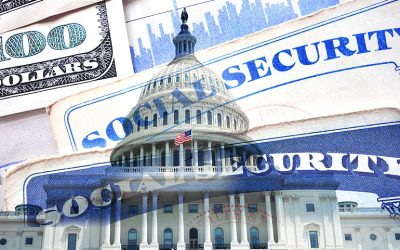

Consider an alternate reality where the American taxpayers have the option to decide between two funding projects, with the first option being 95 billion dollars poured into the American economy to fix infrastructure, help our homeless and poverty-stricken families, repair the damage done by the massive border crises, and send much needed financial aid to those in Hawaii who were devastated by the fire – basically spending billions building up our broken country.
The second option – funding a bill dedicated to wars in other countries, money used to bolster the arsenals of Ukraine, Israel, and Taiwan with an assortment of U.S. military hardware. Money that will be used to enhance the pockets of major U.S. arms manufacturers and those politicians who own stock in them. Along with this, wars and inflation go hand-in-hand, as does a soaring national debt, so choosing this second option would guarantee the people of the United States would be stuck with inflation that will continue to erode their purchasing power.
Which option do you think the U.S. taxpayers would select if given the choice? Would the majority choose the military-industrial complex coupled with inflation instead of the needs of the American people? I don’t think so.
$95 Billion: Senate Passes National Security Act Emergency Spending Package
Well, of course, the taxpayers were not given a choice. As you may already know, earlier this month, although still waiting for approval by the House, the National Security Act Emergency Funding Package for $95 billion was cleared by the Senate, aimed at extending military assistance to Ukraine and Israel, restocking the weaponry of the U.S., and providing funds dedicated to Gaza, and other war-related elements.
As stated by the Congressional Research Service Report – If enacted, Division A of the act would provide approximately $60 billion for Ukraine-related activities. You can get a full overview of how the allocated funds have been and will be used by reading the U.S. Security Assistance to Ukraine Report.
$886 Billion: Defense Authorization Act (NDAA)
If you’re now concerned about taxpayer dollars being siphoned out of the U.S. to fund wars and support other countries, then it may worry you even more to know that just a few months ago, the U.S. House of Representatives overwhelmingly voted in favor of the National Defense Authorization Act (NDAA) for the fiscal year 2024, which included a staggering $886 billion in annual military spending. It authorizes policies such as aid for Ukraine and push-back against China in the Indo-Pacific, among other military-related items.
Current Government Spending Package Holdup
Today, the U.S. House of Representatives, under Republican control, is set to cast a vote on legislation to prevent a partial government shutdown. This move will forward the bill to the Senate, which holds a Democratic majority, just one day before several federal agencies face a lapse in funding. New funding deadlines would appear to be March 8th and March 22nd.
Related to this, U.S. Senate Republican Leader Mitch McConnell, the longest-serving party leader in U.S. history, announced he will step down this November. McConnell has actively supported aid for Ukraine, which has stalled in the House.
Tuesday, showing where his priorities are, Biden urged congressional leaders to avoid a government shutdown and send aid to Ukraine and Israel. He commented on aid to Ukraine, “The need is urgent,” and “The consequences of inaction every day in Ukraine are dire.” Biden also mentioned that we need to replenish the air defenses for Israel.
Dive into this video to hear the real facts about Biden, the possible government shutdown, and the war in Ukraine:
Several issues are contributing to the delay of the government spending package being passed, but it’s clear that congressional leaders are divided when it comes to continuing to fund Ukraine. Some claim we’re abandoning them, while others, like House Speaker Mike Johnson, R-La., want to make issues here at home, like the border, a priority. He makes his stance clear when he says, “My purpose was to express what I believe is the obvious truth, and that is that we must take care of America’s needs first.”
Continued Funding to Ukraine is Doing Them More Harm Than Good
Now, if this money was truly helping the Ukrainians, allocating taxpayer funds to fuel the war could be somewhat justified. However, the track record of the U.S. designating massive waves of funds for Ukraine has actually proven to be destructive to their country.
Numerous reports given by those with boots on the ground and by reputable media outlets, indicate that the conflict has resulted in an enormous loss of life among Ukrainian men. Estimated casualties are 400,000 to 500,000, which was also noted by the number of obituaries published. Alongside this are millions of men who have been injured. It’s worth noting, however, that mainstream media coverage significantly downplays these figures to fit their narrative.
The fact is that each bundle of funding and weapons that the U.S. sends, successfully wipes out a wave of Ukrainian soldiers. The situation has escalated to such an extent that men are being forcibly removed from city buses and cafes and taken to the battlegrounds, a reality that’s been captured in videos taken by Ukrainian bystanders.
The Industrial Military Complex Benefits Not Ukraine or the American People
This path the U.S. is taking clearly isn’t working; it’s not helping the people of Ukraine, but instead lining the pockets of Lockheed Martin, Raytheon, and politicians, as well as fulfilling the self-serving goals of the American government.
Ambassador Victoria Nuland, Assistant Secretary of State for European and Eurasian Affairs, spells it out for us as if it were a benefit to the U.S., as she spoke of Ukraine, “The U.S. has provided $75 billion in security, economic, and humanitarian assistance.” She goes on to say, “And by the way, most of the support we are providing actually goes right back into the U.S. economy and defense industrial base—helping to modernize and scale our own vital defense infrastructure while creating American jobs and economic growth.” She’s not referring to everyday American jobs, but instead to defense-related contractors, subcontractors, and the like.
Hidden Cost of War – National Debt & Crippling Inflation
Spending so much money on Ukraine and other countries will increase our debt, which is over $34 trillion, and keep inflation high. Ultimately, American taxpayers find themselves in the challenging position of financing these conflicts, a situation that leads to a decrease in their purchasing power due to inflation and the burden of an incredibly large national debt.
Rising debt such as this leads to fewer economic opportunities for those who live in the U.S., and debt this high can reduce business investment, slow economic growth, increase inflation, and destroy confidence in the U.S. dollar, among other things.
Of course, other economic factors are impacting our national debt and inflation numbers. Still, when you devalue the U.S. dollar by allocating billions of dollars to other countries to fund wars, you bet it can have a negative effect on the inflation forecast, and this is felt when shoppers are putting less food on the table for their families because the prices have surged beyond affordability – so it certainly doesn’t help.
Furthermore, although many see the whole picture, a great number of taxpayers are unaware that their tax payments are inadvertently contributing to their financial strains, including increased expenses at the grocery store and rising rental costs. With each dollar purchasing less and less due to inflation, this scenario plays out as a hidden cost of war that affects those far from the battlefield.
Protecting Personal Funds from Inflation and the Volatile Economy
While U.S. citizens might not have control over the fact that their contributions are funding wars, they are at least taking steps to counteract the effects. They’re not just sitting on the sidelines, especially with economic and financial uncertainty growing, the latest CPI report coming in higher than expected, a possible interest rate increase headed our way this March, and the fact that there’s talk of a coming recession this year.
These growing concerns have led individuals to explore ways to protect their savings and devise strategies for wealth accumulation that are independent of the volatile economy. This typically includes investing in precious metals such as gold and silver, as well as investing in real estate. The reason for this is that precious metals increase in value when the economy is unstable and rental real estate property values generally increase in value during times of inflation, and rents increase as well. Here are two exceptional resources that will provide you with more information on this subject:
- Why Rental Properties are a Safe Investment During Times of High Inflation
- How Hard Assets Create Wealth and Financial Security for Real Estate Investors
If you’d like to speak with one of our team members to discuss all your options related to investing in real estate, schedule a free call with Morris Invest – we can help you achieve financial security and independence through rental real estate. To learn more about what we offer our clients, please see our main overview page, which contains extensive information on Morris Invest & SDIRA Programs.
For a comprehensive understanding of the current situation in Ukraine, take a moment to view the following video:
Ready To Build Passive Income Through Rental Real Estate?
Ready to talk about your goals? We're here to show you the tools and teach you the process to begin earning legacy wealth for you and your family.








